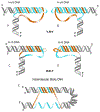Replication dependent and independent mechanisms of GAA repeat instability
- PMID: 35952488
- PMCID: PMC9675320
- DOI: 10.1016/j.dnarep.2022.103385
Replication dependent and independent mechanisms of GAA repeat instability
Abstract
Trinucleotide repeat instability is a driver of human disease. Large expansions of (GAA)n repeats in the first intron of the FXN gene are the cause Friedreich's ataxia (FRDA), a progressive degenerative disorder which cannot yet be prevented or treated. (GAA)n repeat instability arises during both replication-dependent processes, such as cell division and intergenerational transmission, as well as in terminally differentiated somatic tissues. Here, we provide a brief historical overview on the discovery of (GAA)n repeat expansions and their association to FRDA, followed by recent advances in the identification of triplex H-DNA formation and replication fork stalling. The main body of this review focuses on the last decade of progress in understanding the mechanism of (GAA)n repeat instability during DNA replication and/or DNA repair. We propose that the discovery of additional mechanisms of (GAA)n repeat instability can be achieved via both comparative approaches to other repeat expansion diseases and genome-wide association studies. Finally, we discuss the advances towards FRDA prevention or amelioration that specifically target (GAA)n repeat expansions.
Keywords: DNA triplex; Friedreich’s ataxia; GAA repeat instability; H-DNA; Replication fork stalling; Trinucleotide repeats.
Copyright © 2022 Elsevier B.V. All rights reserved.
Conflict of interest statement
Conflict of Interest The authors declare that there are no conflicts of interest.
Figures



Similar articles
-
Large-scale expansions of Friedreich's ataxia GAA•TTC repeats in an experimental human system: role of DNA replication and prevention by LNA-DNA oligonucleotides and PNA oligomers.Nucleic Acids Res. 2023 Sep 8;51(16):8532-8549. doi: 10.1093/nar/gkad441. Nucleic Acids Res. 2023. PMID: 37216608 Free PMC article.
-
Stalled DNA Replication Forks at the Endogenous GAA Repeats Drive Repeat Expansion in Friedreich's Ataxia Cells.Cell Rep. 2016 Aug 2;16(5):1218-1227. doi: 10.1016/j.celrep.2016.06.075. Epub 2016 Jul 14. Cell Rep. 2016. PMID: 27425605 Free PMC article.
-
A novel GAA-repeat-expansion-based mouse model of Friedreich's ataxia.Dis Model Mech. 2015 Mar;8(3):225-35. doi: 10.1242/dmm.018952. Epub 2015 Feb 13. Dis Model Mech. 2015. PMID: 25681319 Free PMC article.
-
Friedreich's ataxia: new insights.Emerg Top Life Sci. 2023 Dec 14;7(3):313-323. doi: 10.1042/ETLS20230017. Emerg Top Life Sci. 2023. PMID: 37698160 Review.
-
Beyond loss of frataxin: the complex molecular pathology of Friedreich ataxia.Discov Med. 2014 Jan;17(91):25-35. Discov Med. 2014. PMID: 24411698 Review.
Cited by
-
Triplex H-DNA structure: the long and winding road from the discovery to its role in human disease.NAR Mol Med. 2024 Dec 5;1(4):ugae024. doi: 10.1093/narmme/ugae024. eCollection 2024 Oct. NAR Mol Med. 2024. PMID: 39723156 Free PMC article.
-
Unstable FGF14 GAA repeat expansions in Indian ataxia patients: a broader phenotype and involvement of modifier loci?J Hum Genet. 2025 Aug 20. doi: 10.1038/s10038-025-01390-6. Online ahead of print. J Hum Genet. 2025. PMID: 40835733
-
DRED: A Comprehensive Database of Genes Related to Repeat Expansion Diseases.Genomics Proteomics Bioinformatics. 2024 Dec 3;22(5):qzae068. doi: 10.1093/gpbjnl/qzae068. Genomics Proteomics Bioinformatics. 2024. PMID: 39348154 Free PMC article.
-
Somatic and intergenerational G4C2 hexanucleotide repeat instability in a human C9orf72 knock-in mouse model.Nucleic Acids Res. 2024 Jun 10;52(10):5732-5755. doi: 10.1093/nar/gkae250. Nucleic Acids Res. 2024. PMID: 38597682 Free PMC article.
-
Large-scale expansions of Friedreich's ataxia GAA•TTC repeats in an experimental human system: role of DNA replication and prevention by LNA-DNA oligonucleotides and PNA oligomers.Nucleic Acids Res. 2023 Sep 8;51(16):8532-8549. doi: 10.1093/nar/gkad441. Nucleic Acids Res. 2023. PMID: 37216608 Free PMC article.
References
Publication types
MeSH terms
Substances
Grants and funding
LinkOut - more resources
Full Text Sources
Medical
Miscellaneous

